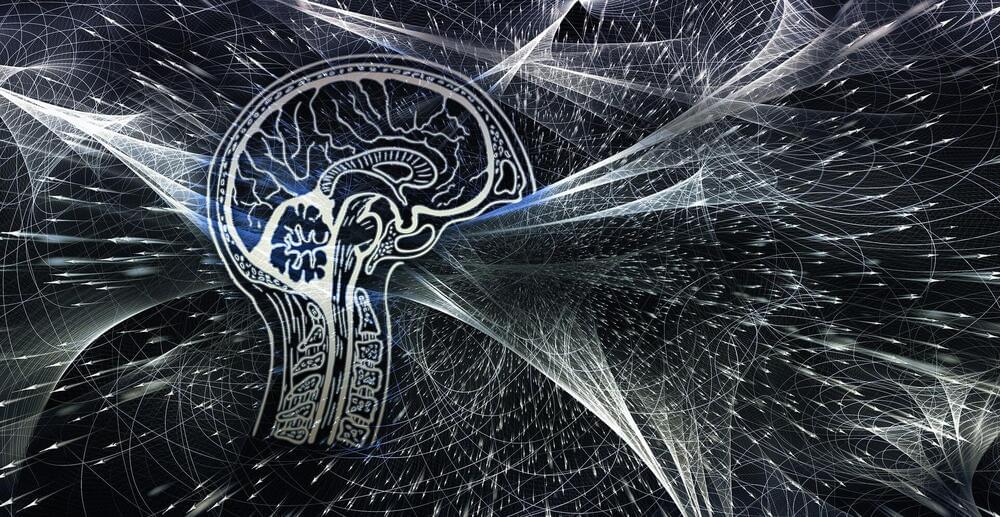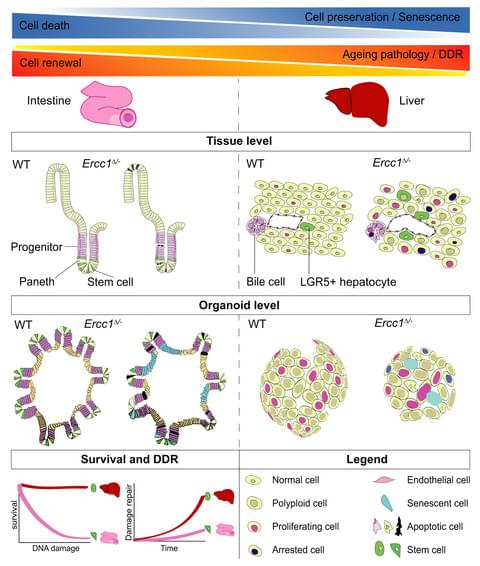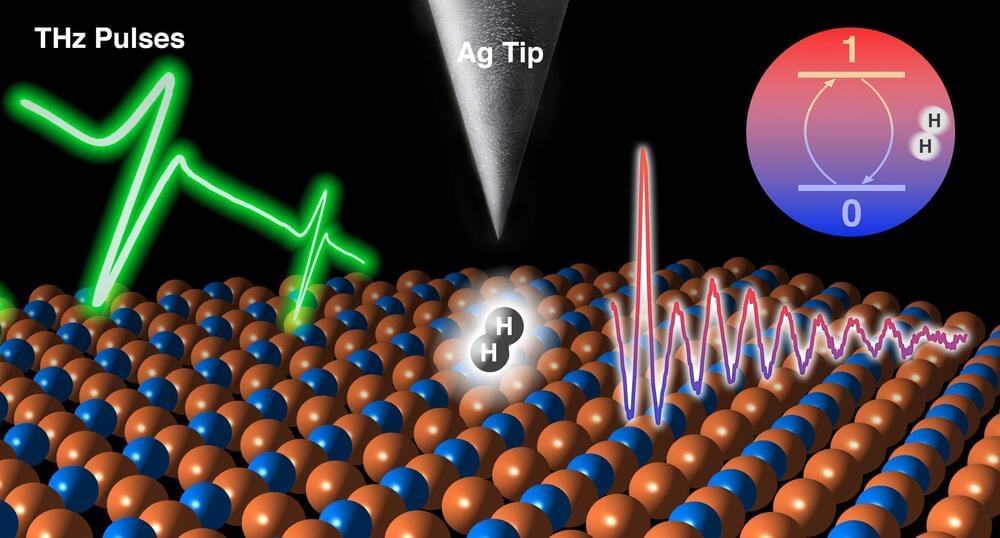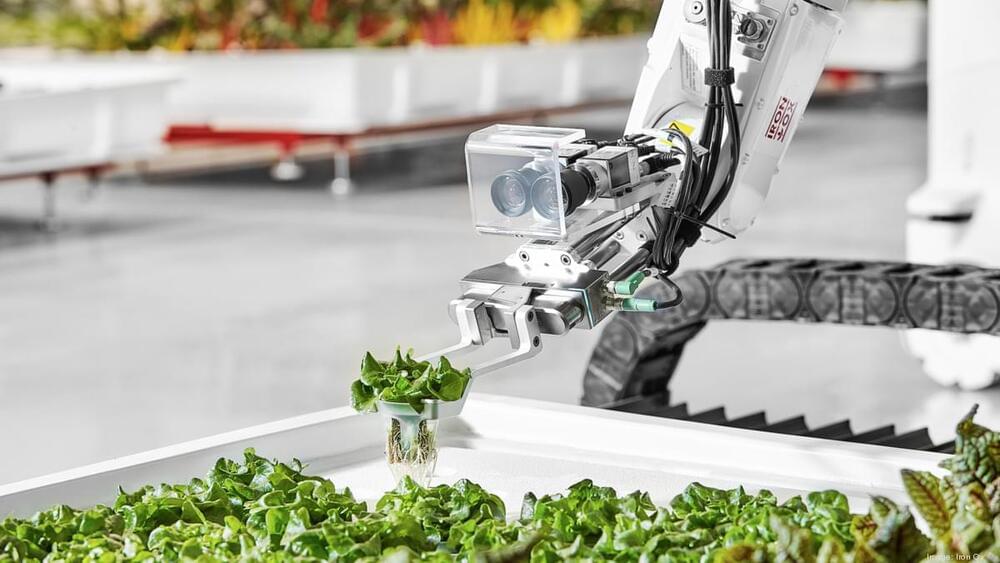Page 4924
Apr 22, 2022
An ocean in your brain: Interacting brain waves key to how we process information
Posted by Dan Kummer in categories: biological, computing, neuroscience
For years, the brain has been thought of as a biological computer that processes information through traditional circuits, whereby data zips straight from one cell to another. While that model is still accurate, a new study led by Salk Professor Thomas Albright and Staff Scientist Sergei Gepshtein shows that there’s also a second, very different way that the brain parses information: through the interactions of waves of neural activity. The findings, published in Science Advances on April 22, 2022, help researchers better understand how the brain processes information.
“We now have a new understanding of how the computational machinery of the brain is working,” says Albright, the Conrad T. Prebys Chair in Vision Research and director of Salk’s Vision Center Laboratory. “The model helps explain how the brain’s underlying state can change, affecting people’s attention, focus, or ability to process information.”
Researchers have long known that waves of electrical activity exist in the brain, both during sleep and wakefulness. But the underlying theories as to how the brain processes information—particularly sensory information, like the sight of a light or the sound of a bell—have revolved around information being detected by specialized brain cells and then shuttled from one neuron to the next like a relay.
Apr 22, 2022
For Neurons, Where They Begin Isn’t Necessarily Where They End
Posted by Dan Kummer in category: neuroscience
Summary: A new study sheds light on the movement of neurons throughout the brain during fetal development. Researchers also found the two hemispheres of the human cortex separated earlier in development than previously thought.
Source: UCSD
The making of a human brain remains a mostly mysterious process that races from an embryonic neural tube to more than 100 billion interconnected neurons in the brain of a newborn.
Apr 22, 2022
Different responses to DNA damage determine ageing differences between organs
Posted by Paul Battista in categories: biotech/medical, life extension
Organs age differently. To investigate the basis of organ-specific ageing we systematically compared at the tissue, stem cell and organoid level two organs representing ageing extremes, from accelera…
Apr 22, 2022
Topological synchronization of chaotic systems
Posted by Quinn Sena in categories: biological, physics
Can we find order in chaos? Physicists have shown, for the first time that chaotic systems can synchronize due to stable structures that emerge from chaotic activity. These structures are known as fractals, shapes with patterns which repeat over and over again in different scales of the shape. As chaotic systems are being coupled, the fractal structures of the different systems will start to assimilate with each other, taking the same form, causing the systems to synchronize.
If the systems are strongly coupled, the fractal structures of the two systems will eventually become identical, causing complete synchronization between the systems. These findings help us understand how synchronization and self-organization can emerge from systems that didn’t have these properties to begin with, like chaotic systems and biological systems.
One of the biggest challenges today in physics is to understand chaotic systems. Chaos, in physics, has a very specific meaning. Chaotic systems behave like random systems. Although they follow deterministic laws, their dynamics still will change erratically. Because of the well-known “butterfly effect” their future behavior is unpredictable (like the weather system, for example).
Apr 22, 2022
Titan’s largest crater might be the perfect cradle for life
Posted by Quinn Sena in categories: chemistry, quantum physics, space
Impacts on Saturn’s mysterious moon may have mixed water and organic molecules in a warm environment.
Physicists at the University of California, Irvine have demonstrated the use of a hydrogen molecule as a quantum sensor in a terahertz laser-equipped scanning tunneling microscope, a technique that can measure the chemical properties of materials at unprecedented time and spatial resolutions.
Apr 22, 2022
Scientists turn a hydrogen molecule into a quantum sensor
Posted by Quinn Sena in categories: chemistry, computing, particle physics, quantum physics
Physicists at the University of California, Irvine have demonstrated the use of a hydrogen molecule as a quantum sensor in a terahertz laser-equipped scanning tunneling microscope, a technique that can measure the chemical properties of materials at unprecedented time and spatial resolutions.
This new technique can also be applied to analysis of two-dimensional materials which have the potential to play a role in advanced energy systems, electronics and quantum computers.
Today in Science, the researchers in UCI’s Department of Physics & Astronomy and Department of Chemistry describe how they positioned two bound atoms of hydrogen in between the silver tip of the STM and a sample composed of a flat copper surface arrayed with small islands of copper nitride. With pulses of the laser lasting trillionths of a second, the scientists were able to excite the hydrogen molecule and detect changes in its quantum states at cryogenic temperatures and in the ultrahigh vacuum environment of the instrument, rendering atomic-scale, time-lapsed images of the sample.
Apr 22, 2022
Scientists develop rapid new method of 3D printing glass into parts with “the thickness of hair”
Posted by Quinn Sena in categories: 3D printing, materials
Researchers at the University of Freiburg have worked with colleagues at the University of California, Berkeley to come up with a novel means of rapidly 3D printing complex glass parts at a microscopic scale.
Known as ‘Microscale Computed Axial Lithography’ (Micro-CAL), this approach involves exposing resin to 2D light images of a desired shape from multiple angles, which when they overlap, trigger polymerization. When used to print the Glassomer material previously honed at Freiburg, the team say their layer-free process has the potential to unlock devices with new microfluidic or micro-optical functionality.
“For the first time, we were able to print glass with structures in the range of 50 micrometers in just a few minutes, which corresponds roughly to the thickness of a hair,” explains the University of Freiburg’s Dr. Frederik Kotz-Helmer. The ability to manufacture such components at high speed and with great geometric freedom will enable new functions and more cost-effective products in the future.”
Apr 22, 2022
Domestic cats (Felis catus) discriminate their names from other words
Posted by Quinn Sena in category: food
Circa 2019
Domestic cats (Felis catus) and dogs (Canis familiaris) are the most popular companion animals; worldwide, over 600 million cats live with humans1, and in some countries their number equals or exceeds the number of dogs (e.g., Japan: dogs: 8,920,000, cats: 9,526,000)2,3. Cats started to cohabit with humans about 9,500 years ago4; their history of cohabitation with humans is shorter than that of dogs5, and they have been domesticated by natural selection, not by artificial selection6,7,8. Despite these differences in their process of domestication compared to that of dogs, cats too have developed behaviours related to communication with humans; for example, for human listeners, the vocalisations of domestic cats are more comfortable than those of African wild cats (Felis silvestris lybica)9. In addition, purring has different acoustical components during solicitation of foods than at other times, and humans perceive such solicitation purrs as more urgent and unpleasant than non-solicitation purrs10. These facts clearly indicate that domestic cats have developed the ability to communicate with humans and frequently do so; Bradshaw8 suggested that this inter-species communicative ability is descended from intra-species communicative ability.
Researchers have only recently begun to investigate cats’ ability to communicate with humans. Miklósi et al. showed that cats are able to use the human pointing gesture as a cue to find hidden food, similarly to dogs11. The researchers also suggested that cats do not gaze toward humans when they cannot access food, unlike dogs. However, a recent study revealed that cats show social referencing behaviour (gazing at human face) when exposed to a potentially frightening object, and to some extent cats changed their behaviour depending on the facial expression of their owner (positive or negative)12. Cats in food begging situations can also discriminate the attentional states of humans who look at and call to them13. In addition, Galvan and Vonk demonstrated that cats were modestly sensitive to their owner’s emotions14, and other research has indicated that cats’ behaviour is influenced by human mood15,16. Further, cats can discriminate their owner’s voice from a stranger’s17. This research evidence illustrates that domestic cats have the ability to recognize human gestural, facial, and vocal cues.
Continue reading “Domestic cats (Felis catus) discriminate their names from other words” »
Apr 22, 2022
First look: Robots helping harvest crops in Central Texas
Posted by Shubham Ghosh Roy in categories: food, particle physics, robotics/AI
The future is here.
Hints of a new particle carrying a fifth force of nature have been multiplying at the LHC – and many physicists are convinced this could finally be the big one.


















